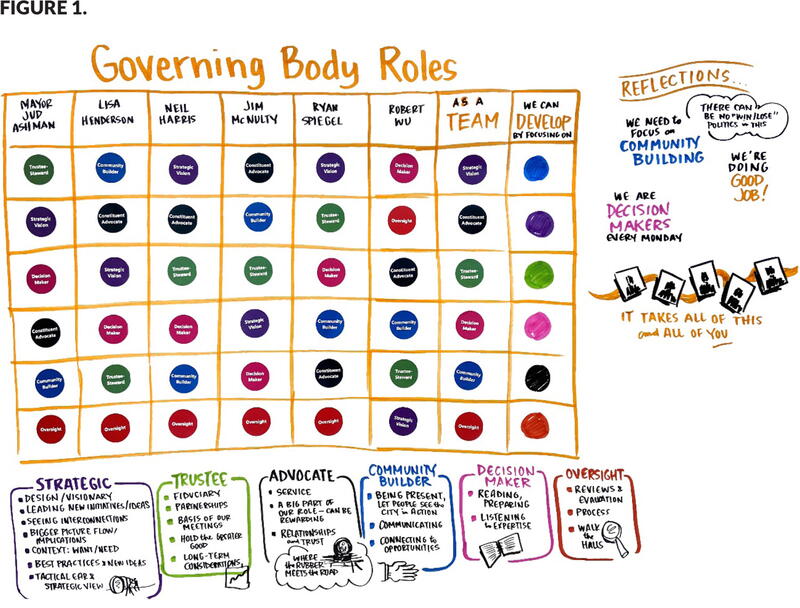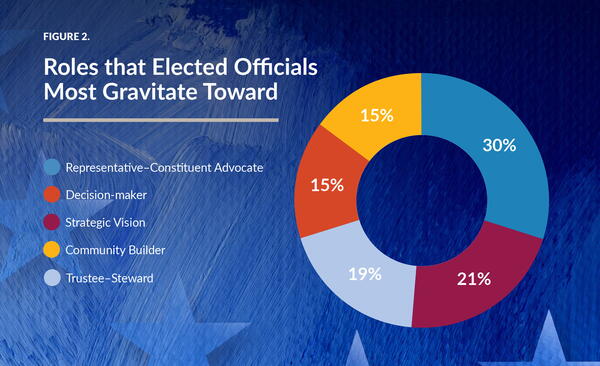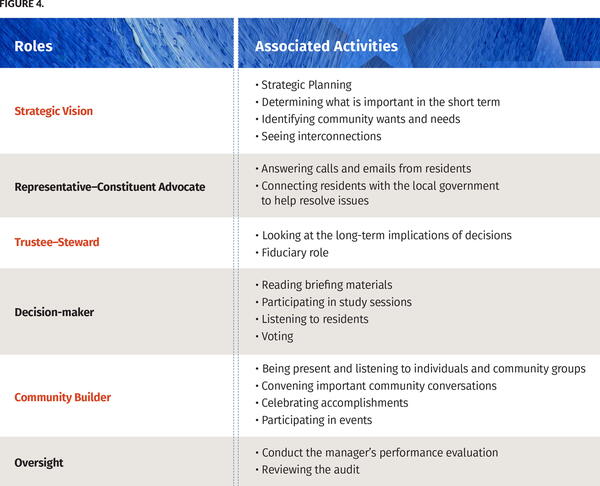
Management is a supporting and essential role in local governance. Management supports the organization, the community, and, of course, the governing body. There is a dance that managers must do with their elected officials as they navigate the curved and blurry line between politics and administration, but this symbiotic relationship is built on the foundational premise that management is a supporting role.
Just as a manager’s role changes with each situation they encounter, the role an elected official plays also shifts and changes. In 2016, we began working to define the various roles that local elected officials must play and identify how those roles relate to effective governance. Since that time, we have worked with dozens of elected bodies to understand these roles, the activities associated with each role, and how elected officials envision enhancing their own effectiveness.
These insights can be valuable to managers as they fine tune their “support role” and understand what can be done to help their elected body in governing effectively together.
The Roles
Through our work, we identified six council governance roles : Strategic Vision–Big Picture Thinker, Trustee–Steward, Representative–Constituent Advocate, Community Builder–Bringing People Together, Decision-maker, and Oversight.

• The Strategic Vision–Big Picture Thinker role focuses on decisions that can have significant impact on the community, both long- or short-term. This role often concentrates on the future and what might make a significant difference, while seeing possible connections and relationships and thinking beyond present data and constraints.
• The Trustee–Steward role involves listening to and respecting constituent views. The Trustee–Steward feels responsible to the community as a whole and to future residents and will make uncomfortable decisions that may run counter to constituent wishes if the decision is in the interest of the greater good.
• When operating in the Representative–Constituent Advocate role, an elected official acts as a “customer service representative.” In this capacity, the elected official is a conduit between residents and local government services. Often, residents see this elected official as most responsive to their individual concerns.
• In the Community Builder–Bringing People Together role, an elected official focuses on relationships and consensus-building. The Community Builder fosters relationships and can work through differences. Community is not just a casual word to the elected official who gravitates to this role.
• The Decision-maker sees their role much like a judge, wherein information is presented and the Decision-maker votes it up or down. This is not an easy role, but often it is a more passive role in contrast to that of the Community Builder.
• In the Oversight role, the elected official may retain a measure of distance from the staff. The focus of this role is on the accountability of staff to the elected body.
Since the development of the six governance roles roles in 2016, conversations about the roles have been incorporated into retreats with governing bodies across the country. During these retreats, the groups discuss the activities associated with each of the roles and then individuals are asked to rank for themselves the roles that come most naturally. The percentage of respondents ranking each of the corresponding roles as where they gravitate toward the most is shown in Figure 2.

It is interesting to note that none of the more than 200 elected officials we have worked with identified Oversight as the role that they naturally gravitate toward and yet this is the role that creates distance and tension between staff and the governing body.
Once we understand how each individual ranks and identifies with the six roles, we are able to provide an aggregate ranking or group profile. The following is the collective distribution of which roles governing bodies naturally gravitate toward:
- Representative–Constituent Advocate.
- Strategic Vision.
- Trustee–Steward.
- Decision-maker.
- Community Builder.
- Oversight.
Then they are asked to discuss what roles they feel they should focus more on to enhance effectiveness. The following is the collective distribution of which roles governing bodies feel they should focus on to be (even) more effective:
- Strategic Vision.
- Community Builder.
- Trustee–Steward.
- Representative–Constituent Advocate.
- Decision-maker.
- Oversight.
The challenge for managers is to support the governing body in each of the roles to enhance effectiveness. Figure 3 allows us to see the juxtaposition of a few key elements of this ranking. Generally speaking, Representative–Constituent Advocate is the number-one role that elected officials naturally gravitate toward and Community Builder is number five. When asked where to focus to enhance effectiveness, Community Builder jumps to number two, and Representative–Constituent Advocate moves to number four. Finally, the Oversight role is the lowest rated role in both scenarios.

The Activities
A quick summary of activities associated with each role is shown in Figure 4.
The reality for our elected officials is that there are times when these roles are in opposition to one another. Residents may be asking the council to vote a particular way on an issue because of how that decision impacts them in the moment, but the Trustee–Steward will consider long-term implications and perhaps make a different decision. When discussing this tension at a council retreat, one councilmember described this as a mindset they take on when considering important decisions: “If I think of our residents, the voters, my neighbors as my customers, then I am their customer service; but when I think of them as owners, then I am their trustee.” The trustee is duty bound to make decisions in the best interest of the community, even despite “customer” opposition to do so.
The Community Building role deserves special attention since there is noticeable separation from actual and desired ranking. As elected officials think about moving the needle on their own performance as a governing body, they see the Community Building role as a potential pathway. Parks, gathering areas, community centers, and town squares are physical spaces we can build and maintain that allow people to gather and be connected to their neighbors. Programming those areas with special events and celebrations encourages people to engage directly with the local government and the community. Convening conversations about important community issues are also an opportunity to reinforce that the local government cares about the events and issues facing the community and wants to hear from residents. The balance, of course, is to create an environment for true civil discourse. Many of our traditional methods of getting public input, such as public hearings where people get three minutes to state their opinion, are not consistent with community building—or even real engagement. Community Building is deeper. According to Nalbandian, “win-lose politics have no place if community building is the goal.”

Given the divergence between the actual role a governing body gravitates toward and their desired role, the question is, how do we do this? What can the manager and staff do in this supporting role to help the governing body achieve the best for their community?
Our practical experience as consultants and managers suggests the following:
1. Intentionally plan for opportunities for the governing body to fulfill each role, and create a time at council meetings where councilors can share their recent activities in the community. This publicly encourages councilors to reach out.
2. Create systems for efficiently addressing constituent concerns so elected officials can turn these issues over to the staff and not feel like they must be the ombudsman for the public, while at the same time, receiving credit for staff responses.
3. Refer to strategic plans and long-range goals when executing programs and projects to create connections between the daily work of the organization and the priorities of the elected officials. This could mean connecting agenda items directly to governing body priorities.
4. Discuss both short- and long-term consequences of action (or inaction).
5. Support the governing body in establishing ground rules for civility and mutual accountability.
6. Demonstrate accountability to the governing body by updating them on the status of agreed upon priorities and ensuring a meaningful process exists for performance evaluations.
In Gaithersburg, Maryland, there is a long tradition of strategic planning, financial stewardship, civility, and community engagement. When Tanisha Briley became their city manager, her job was to build on this foundation and “level up” organizational performance. “The challenge was to take an already high-performing governing body and integrate new elected officials into the best part of the governance culture,” she said. “We did that by intentionally talking about the importance of working well together to achieve results and refreshing the strategic plan so the council was connected and committed to the long-term goals of the city.”
A Cautionary Conclusion
As was stated in the beginning, management is a supporting role and while their primary focus is the complexity of service delivery issues, fulfilling that role means supporting the governing body in each of theirs. It must be intentional and the manager must be in tune with the priorities of the elected officials and be effective in translating those into administrative/service delivery decisions. We have facilitated governance conversations with dozens of governing bodies and hundreds of individual elected officials. Only two governing bodies felt it was most important to focus on their Oversight role to improve effectiveness and, in both of those situations, the manager moved on within the year.
Accountability is an important part of being a local government professional and builds trust between the governing body and the administration. However, it is equally important to support the governing body in achieving their objectives. This ensures alignment between “politics and administration” and creates a collaborative mentality that can foster aspirational goals for the community.

JULIA NOVAK, ICMA-CM, is a former city manager and leads the management consulting practice for Raftelis. She has facilitated hundreds of governance and goal setting/strategic planning retreats with local governments across the country.

TANISHA BRILEY, ICMA-CM, has spent 15 years in city management, including her current post as city manager in Gaithersburg, Maryland. She is a fellow of the National Academy of Public Administration, and she currently serves as chair of the Board of Directors for MissionSquare Retirement.

JOHN NALBANDIAN, professor emeritus in the School of Public Affairs and Administration at the University of Kansas, prepared hundreds of students for careers in local government, and also served for eight years on the city council of Lawrence, Kansas, including two terms as mayor.
New, Reduced Membership Dues
A new, reduced dues rate is available for CAOs/ACAOs, along with additional discounts for those in smaller communities, has been implemented. Learn more and be sure to join or renew today!
